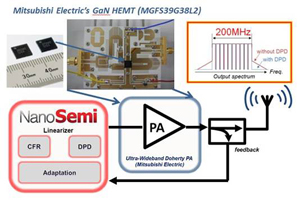Mitsubishi Electric US Inc. will present a hands-on mini lab showcasing its high-efficiency, wideband GaN Doherty amplifier at Radio Wireless Week (RWW), January 15–16 at the Hyatt Regency Orange County in Garden Grove, California.
Mitsubishi Electric Corporation and Mitsubishi Electric Research Laboratories, Inc. presented a paper titled 3.0–3.6 GHz Wideband, over 46% Average Efficiency GaN Doherty Power Amplifier with Frequency Dependency Compensating Circuits at last year’s RWW, describing this wideband Doherty power amplifier design technique for next-generation LTE base stations using GaN transistor technology. The demonstration at RWW2018 further illustrates the ability to linearize an ultra-wideband signal applied to Mitsubishi Electric’s GaN power amplifier, using an advanced pre-distortion technique provided by NanoSemi Inc.
Conventional base station Doherty power amplifier design presents many challenges to simultaneously achieve both high efficiency and low distortion for wideband carrier aggregation. Using NanoSemi’s digital pre-distortion (DPD) technology, Mitsubishi Electric’s wideband Doherty power amplifier can achieve high efficiencies with up to 200 MHz instantaneous bandwidth, while maintaining ACLR of −50dBc. With this breakthrough, base station designers gain the ability to design a single flexible LTE power amplifier capable of many carrier aggregation scenarios, even above 3 GHz.
Doherty Power Amplifier Performance at 3.5 GHz
|
Carrier Configuration |
Efficiency (%) |
Output Power (dBm) |
ACLR (dBC) |
|---|---|---|---|
|
100 MHz (5 LTE carriers x 20 MHz) |
47.9 | +34.0 | -50.0 |
| 160 MHz (8 LTE carriers x 20 MHz) | 46.2 | +33.9 | -50.8 |
| 200 MHz (4 LTE carriers x 20 MHz) | 47.5 | +34.2 | -50.6 |
| 200 MHz (10 LTE carriers x 20 MHz) | 44.4 | +33.2 | -50.5 |
Data measured at room temperature. Measurements may vary board to board.
Kyle Martin, VP and general manager of Mitsubishi Electric's U.S. semiconductor division, said, “The proliferation of smartphones and tablets will require a dramatic increase in wireless capacity of base stations. To meet this demand, mobile technologies are moving to next-generation LTE, in which the wireless capacities are increased by allocating multiple simultaneous frequency bands (carrier aggregation) above 3 GHz. Operating in multiple simultaneous frequency bands usually requires multiple power amplifiers to cover each frequency band, leading to an increase in the size of base stations.”
RWW2018 attendees are invited to stop by the Mitsubishi Electric US Booth #201/300 at RWW2018 for more information and to view the latest GaN technology.
Mitsubishi Electric’s full line-up of GaN devices, with frequencies in cellular, Ku- and Ka-Bands at output powers ranging from 2 to 100 W, supports a wide variety of end-communications applications, including cellular base station, satellite, ground station and point to point radio.

